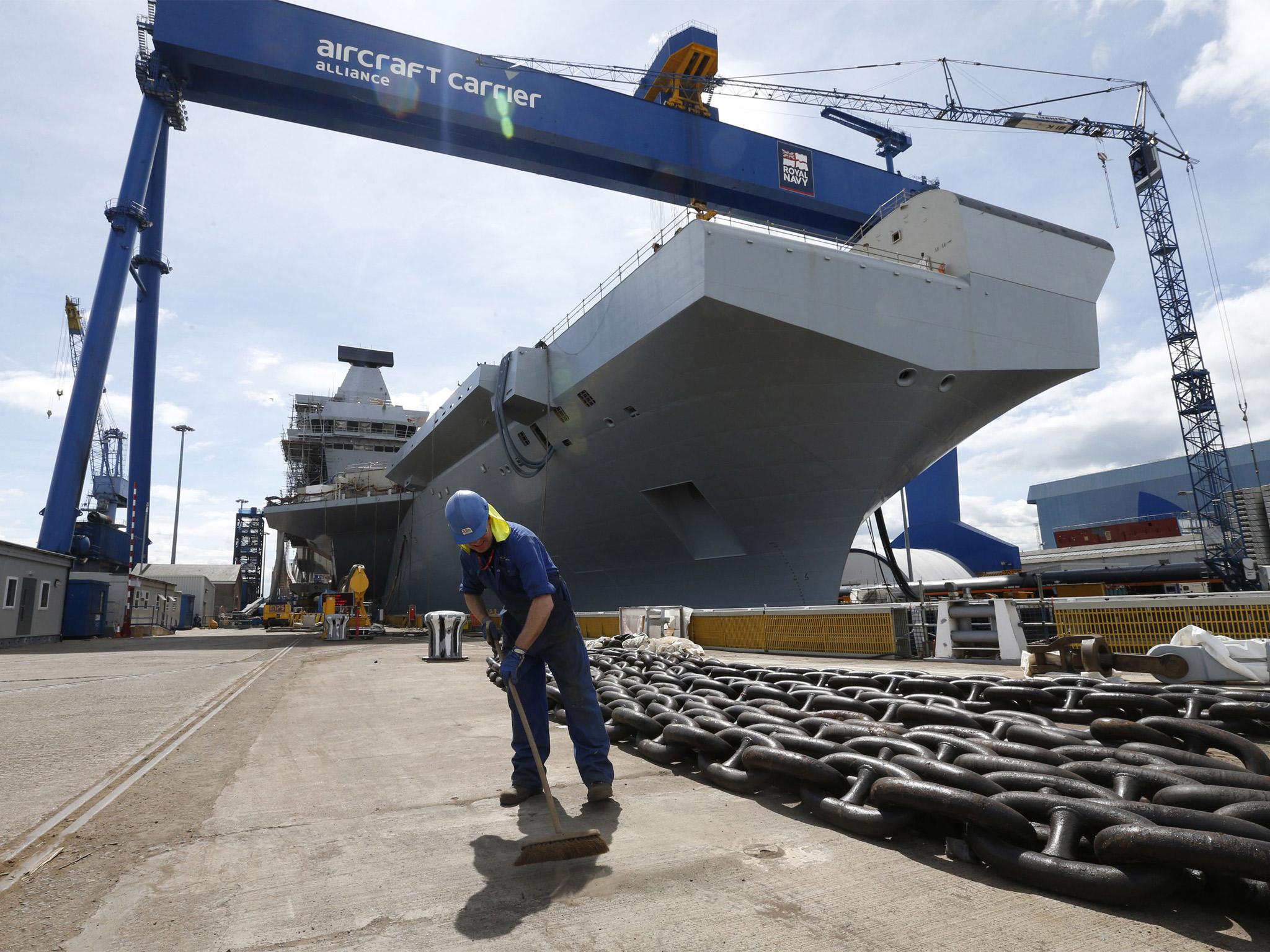Inside HMS Queen Elizabeth: The construction of the Royal Navy's largest ever vessel

It’s the largest warship ever built for the Royal Navy, proudly bearing the name of the sovereign, but the Scottish dock workers constructing aircraft carrier HMS Queen Elizabeth, are all aware they are working on the last warship order of this size that Britain will commission for at least 50 years.
Next month HMS Queen Elizabeth is to be named by her namesake the Queen in a traditional champagne ceremony at Rosyth, where she has been constructed from components forged across the county. Then she will free the giant dry dock for her sister ship the Prince of Wales, but for now she is firmly in place and today, The Independent had early access to the warship before she floats for the first time.
“HMS Queen Elizabeth is designed around the F-35B Lightning II jet and once operational in 2020 will be capable of tasks ranging from humanitarian assistance to air strikes on the first day of a high-intensity conflict,” said Captain Simon Petitt, the Royal Naval officer in charge, who is working with the Aircraft Carrier Alliance, including BAE Systems, Babcock and Thales, to bring the ship into service.
She may not be operational just yet - she officially becomes a military vessel in 2017 - but HMS Queen Elizabeth has taken form already, towering above the quayside with a 4.5-acre flight deck, dwarfing the size of the Royal Navy’s previous generation of carriers.
When deployed she will have a range of 10,000 miles, be able to steam 500 miles a day and be able to carry a mixture of 40 jets and helicopters, as well as up to 1,600 embarked service personal, including a crew of 679. She will, as the Royal Navy loves to say, be able to "project force".
There was hubbub of activity today, with 1,400 workers putting on the last of seven paints of battleship grey ahead of the Royal visit, but the new class of warship has been plagued by overuns and delays, doubling in cost from £3.1bn to £6.2bn, and recently earned an embarrassing “red” warning from the Major Projects Authority.
On board ship though most workers seem more keen on pointing out the vast “Goliath” crane which help pull together the ship’s 40,000 tonnes of steel and 17 million individual parts. Inside it boasts 3,013 modern-looking compartments with 3.1 million metres of cable, 362,000 miles of pipes and 250,000 litres of battleship grey paintwork. In places it looks very much complete.
Next month the Queen will be joined by David Cameron, but also Scottish First Minister Alex Salmond, to name the ship. Captain Petitt said, “It’s a day to celebrate the industry of shipbuilding, I’ll leave the worrying about the seating plan to the First Sea Lord’s Office.”
On the rust-coloured deck, scaffolding contractor Gerard McCue, 52, is happy for the Queen “to visit” and “perhaps” remain head of state, but is adamant he’ll be voting for independence and that one of the two carriers should remain Scottish.
“We’re waiting for a yes vote on 18 September then we should seize this ship for Scotland. I'm all for common defence and the Queen is welcome as a head of state to name her, but I will be voting yes, to vote for Scotland and Scottish jobs. That's whats more important,” he said, before was hurried away by his foreman for a “job up top” on one of the carrier's two islands, seemingly at the behest of a BAE Systems public relations minder.
Most workers on the carrier, which will serve for 50 years, seem to be in the no camp however, and point to the fact that the ship was built at half a dozen sites across the UK, and that BAE Systems alone supports 3,000 shipbuilding jobs in Scotland.
John McLaughlin, a BAE Systems shift manager on the ship, is certain she will act as “symbol of the Union” and is optimistic that the politically charged decision to shift the firm's focus from the south of England to the Clyde for the forthcoming Type 26 Frigate programme will secure ship-building jobs in Scotland well after HMS Queen Elizabeth and HMS Prince of Wales leave Rosyth.
Join our commenting forum
Join thought-provoking conversations, follow other Independent readers and see their replies
Comments